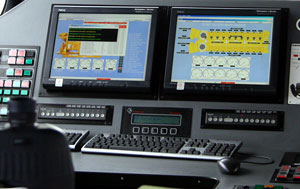


|

|
|
|
Home |
The Mil & Aero Blog
 Posted by John Keller New initiatives to equip U.S. surface warships with the latest computer and networking equipment clearly indicate that the U.S. Navy not only is starting to understand the notions of open systems and industry standards, but also is starting to get serious about this innovative way of procurement. Perhaps the most important indicator is the Navy's Consolidated Afloat Network Enterprise System -- otherwise known as CANES -- which seeks to alter the Navy's currently unaffordable path of legacy applications and network acquisition in efforts to improve command, control, communications, computers, surveillance, and reconnaissance (C4ISR) capability. Navy experts say they eventually would like to see a single suite of survivable common hardware able to host a wide variety of near-real-time combat support applications as they move forward with the CANES Common Computing Environment (CCE) network. In addition, Navy leaders expect the CANES program to fall into line with commercial business information technology (IT) trends and move away from the traditional U.S. Defense Department integrated hardware and software stack legacy systems. To my eye, this means that Navy technology experts plan -- often for the first time -- to follow trends in commercial industry IT trends rather than to specify the service's own unique computer and network architectures and standards. This may not sound like a big deal, but actually it's huge. The Navy has a long history of unique, closed-system computer architectures going back to the shipboard UYK computers and airborne AYK computers. These systems -- although they often were adequate for their assigned tasks -- fell hopelessly behind the computing state of the art, and were difficult to upgrade. Years ago the Navy tried to move toward open systems and industry standards with the Next Generation Computer Resources (NGCR) program, which sought to pick the best of industry standards and computer architectures. NGCR did not have a lasting big influence because it was not flexible enough to incorporate evolving technologies. The CANES program, for which industry teams are forming now for a future series of competitions, sounds fundamentally different. It's a signal that the Navy will become a technology follower rather than application-specific developer, and will have the best shot it has ever had in crafting computer and network architectures that are easily maintained and able to accept rapid and frequent technology insertion and refresh. << Home |
Welcome to the lighter side of Military & Aerospace Electronics. This is where our staff recount tales of the strange, the weird, and the otherwise offbeat. We could put news here, but we have the rest of our Website for that. Enjoy our scribblings, and feel free to add your own opinions. You might also get to know us in the process. Proceed at your own risk. 
John Keller is editor-in-chief of Military & Aerospace Electronics magazine, which provides extensive coverage and analysis of enabling electronic and optoelectronic technologies in military, space, and commercial aviation applications. A member of the Military & Aerospace Electronics staff since the magazine's founding in 1989, Mr. Keller took over as chief editor in 1995.  Courtney E. Howard is senior editor of Military & Aerospace Electronics magazine. She is responsible for writing news stories and feature articles for the print publication, as well as composing daily news for the magazine's Website and assembling the weekly electronic newsletter. Her features have appeared in such high-tech trade publications as Military & Aerospace Electronics, Computer Graphics World, Electronic Publishing, Small Times, and The Audio Amateur.
Courtney E. Howard is senior editor of Military & Aerospace Electronics magazine. She is responsible for writing news stories and feature articles for the print publication, as well as composing daily news for the magazine's Website and assembling the weekly electronic newsletter. Her features have appeared in such high-tech trade publications as Military & Aerospace Electronics, Computer Graphics World, Electronic Publishing, Small Times, and The Audio Amateur.
 John McHale is executive editor of Military & Aerospace Electronics magazine, where he has been covering the defense Industry for more than dozen years. During that time he also led PennWell's launches of magazines and shows on homeland security and a defense publication and website in Europe. Mr. McHale has served as chairman of the Military & Aerospace Electronics Forum and its Advisory Council since 2004. He lives in Boston with his golf clubs.
John McHale is executive editor of Military & Aerospace Electronics magazine, where he has been covering the defense Industry for more than dozen years. During that time he also led PennWell's launches of magazines and shows on homeland security and a defense publication and website in Europe. Mr. McHale has served as chairman of the Military & Aerospace Electronics Forum and its Advisory Council since 2004. He lives in Boston with his golf clubs.
Previous Posts
Archives
|
|||||
Internet gems
THE MAE WEBSITE AUTHORS ARE SOLELY RESPONSIBLE FOR THE CONTENT AND ACCURACY OF THEIR BLOGS, INCLUDING ANY OPINIONS THEY EXPRESS, AND PENNWELL IS NOT RESPONSIBLE FOR AND HEREBY DISCLAIMS ANY AND ALL LIABILITY FOR THE CONTENT, ITS ACCURACY, AND OPINIONS THAT MAY BE CONTAINED HEREIN. THE CONTENT ON THE MAE WEBSITE MAY BE DATED AND PENNWELL IS UNDER NO OBLIGATION TO PROVIDE UPDATES TO THE INFORMATION INCLUDED HEREIN.
|
||||||
|
|
Home | About Us | Contact Us | Corporate Website | Privacy Policy | Courage and Valor Foundation | Site Map
Also Visit: Laser Focus World | Vision Systems Design | Industrial Laser Solutions Copyright © 2007: PennWell Corporation, Tulsa, OK; All Rights Reserved. | Terms & Conditions | Webmaster |
Wednesday, June 4, 2008 2:17:00 PM EDT
Best
Frank
Thursday, September 11, 2008 9:30:00 AM EDT